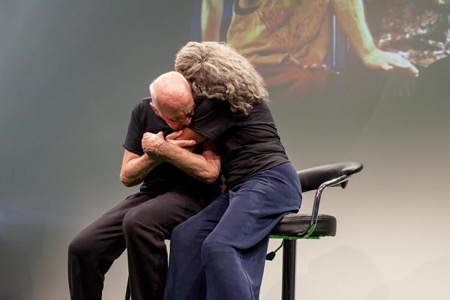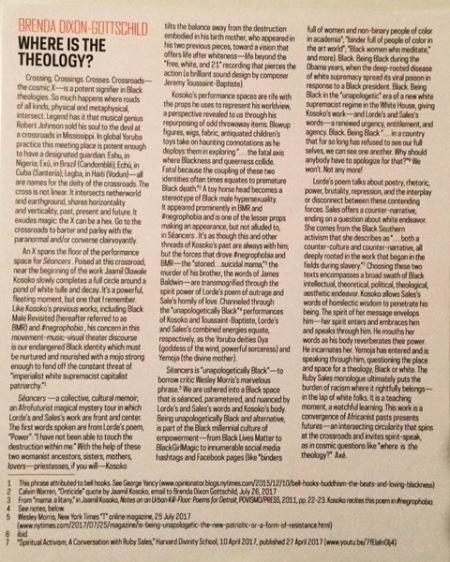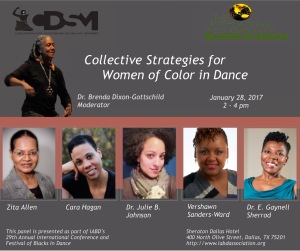This wonderful review of the performance by my husband, Hellmut Gottschild, and me at the Berlin’s international dance festival, Tanz Im August, is on the Festival website’s blog. Ironically and sadly, we were performing in Germany while the news was breaking, globally, about the racist massacre of demonstrators in Charlottesville, VA. The beautiful photo’s the work of German Palomeque, official Festival photographer.

In Bodies We Trust: Brenda Dixon-Gottschild and Hellmut Gottschild refuse to give the word the last word
by Lily Kelting, 14 Aug 2017
Brenda Dixon-Gottschild & Hellmut Gottschild: In Bodies We Trust | Credit: German Palomeque
Fifty years ago, the Lovings, an interracial couple, won a case against the state of Virginia. Mildred and Richard Loving had been imprisoned because their marriage was illegal according to the Racial Integrity Act of 1924; they challenged the ruling, and challenged again, until the Supreme Court of the United States made interracial relationships legal in all states. Which means, explains African-American Brenda Dixon-Gottschild, solemnly arm-in-arm with her German-American husband Hellmut Gottschild, that had they gotten married before 1967, they would have been in trouble. “We would have gone to jail,” underscored Hellmut. “In Bodies We Trust—Tongue Smell Color Revisited”, the opening event of the Bibliothek im August on Saturday, is a reflection on the performers’ touring “movement theater discourse” work “Tongue Smell Color”, which is in turn a reflection on race, sex, and power. The episodic and layered piece is rooted in the dynamics of their own interracial relationship but raises questions about popular culture (the media’s treatment of Serena Williams) and history (the tragic story of Sara Baartman, the exotified so-called Venus Hottentot). We see the influence of Brenda’s life of reading and Hellmut’s training in mime and modern dance. Hellmut and Brenda grapple with their own inner lives—curiosity about the other, exoticizing one’s own partner—in public.
But fifty years is a long time, right? And the two hundred years since the death of Sara Baartman even longer. Is this relevant? Tanz im August artistic director Virve Sutinen asks this question of Brenda in a press conference. Hellmut asks this question aloud of himself in our conversation. He asks us the audience, at the close of the performance. Minutes before the event, I check my phone to see news of a white supremacist rally in Charlottesville, Virginia: open and on the streets. So here’s my response: yes, relevant. We—and here I really do mean the most inclusive and global we—still desperately need conversations about race, sex, and power. The nexus between American white supremacy and the ongoing legacy of Nazi fascism became eerily clear this weekend. I am thinking of the very specific, very personal, even confessional, story of Hellmut and Brenda’s own relationship while following from afar the events unfolding in Virginia 2017. No, fifty years is not a long time. Brenda explains to me: “The Venus Hottentot trope, like racism, still exists. It turns, it twists, it goes underground, but it’s still there. The way that the black female body is represented and received is still very similar even though it’s 150 years later. Plus ça change…” The more things change, the more things stay the same. Movement, theater, discourse—dance—can help us see it.
In a moving section at the beginning of “In Bodies We Trust”, Brenda and Hellmut detail similarities between their two childhoods. “I grew up in a big city.” “I grew up in a big city.” “The butcher was German.” “The butcher was German.” But then things start to diverge. “The number runner was black.” “What’s a number runner?” And finally, from Brenda—“The milkman was Jewish.” Hellmut freezes as though paralyzed. Like the blood in his veins has turned to ice. “The milkman was Jewish…” Brenda repeats. The moment hangs heavy in the air.
After the presentation, the pair continue to the front of the stage for a conversation, a key part of each of their events. They ask us not to assume a critical distance but to stay with the piece, to sit with the issues. What follows is one of the most earnest, open, and respectful public discussions I have ever been a part of. Two German women tearfully reiterate the power of that milkman moment—the way that Hellmut’s movement score brought life to what one eloquently called “a silence that is more than silence.” A teenager processes racist microaggressions he experienced at school. We need these conversations.
“In Bodies We Trust” is such a catchy title, you forget what it might mean. Where better to process my emotional and embodied responses to this weekend’s news than after watching this performance? Who better to facilitate discussions this August than “thinking body and dancing mind” Brenda Dixon-Gottschild? I try to crib a few notes: how is she so successful at getting roomfuls of strangers of all different backgrounds to open up? “I try to keep it focused on the issues. Where do you as the audience find yourself in that? Rather than, how do you remove yourself and then make an intellectual question about it. I don’t want the words to win out. As Hellmut says: ‘We will not give the word the last word.’” No: In Bodies We Trust.



